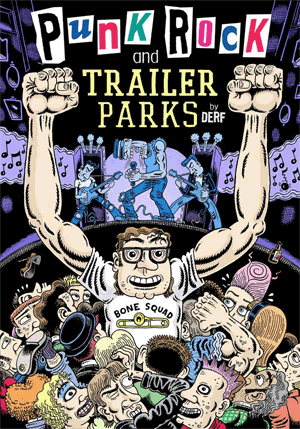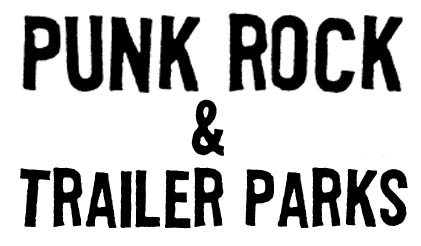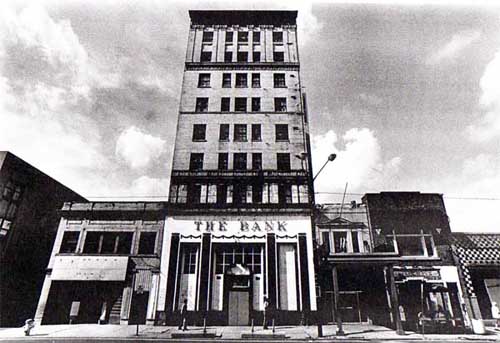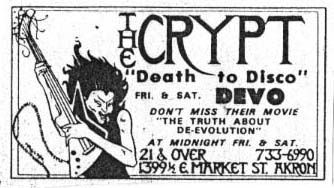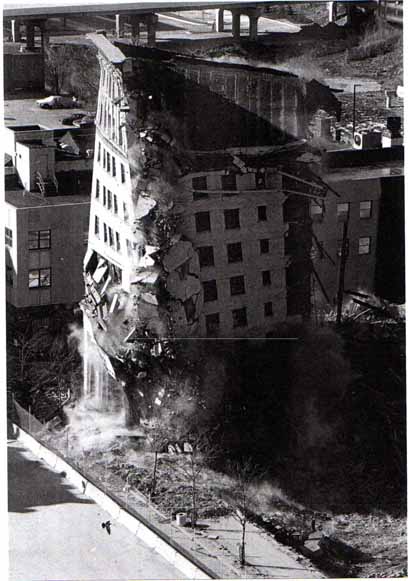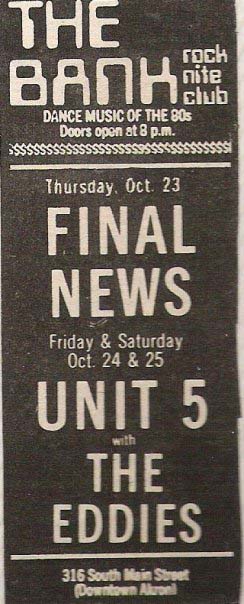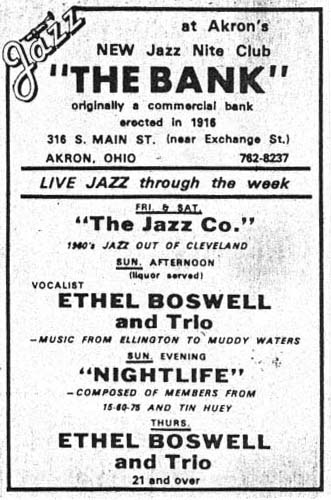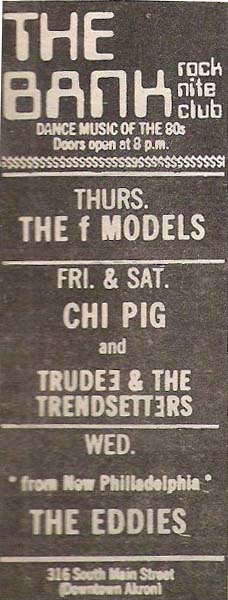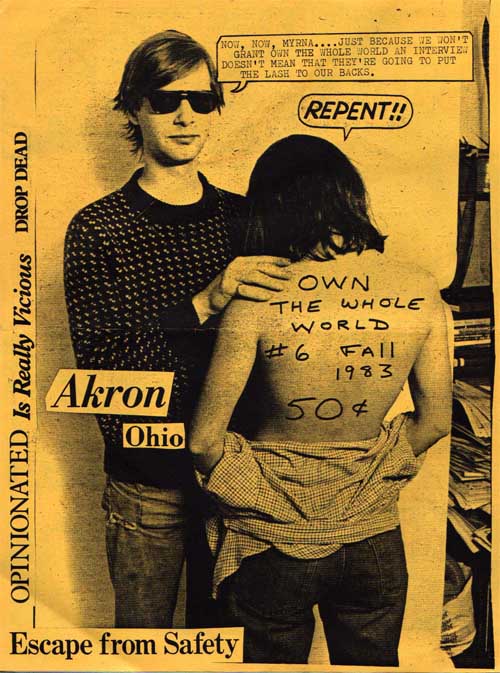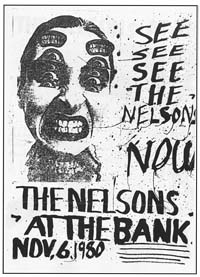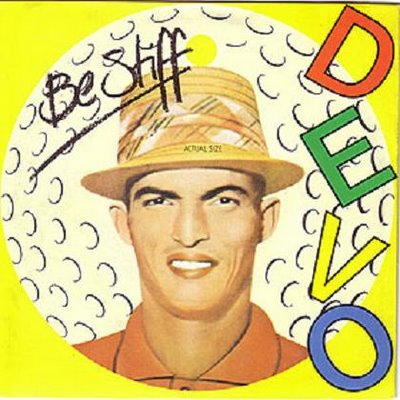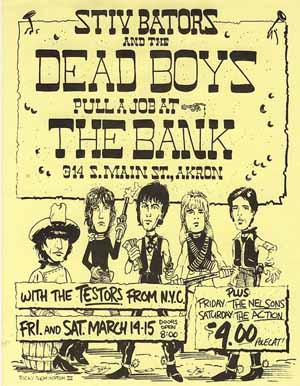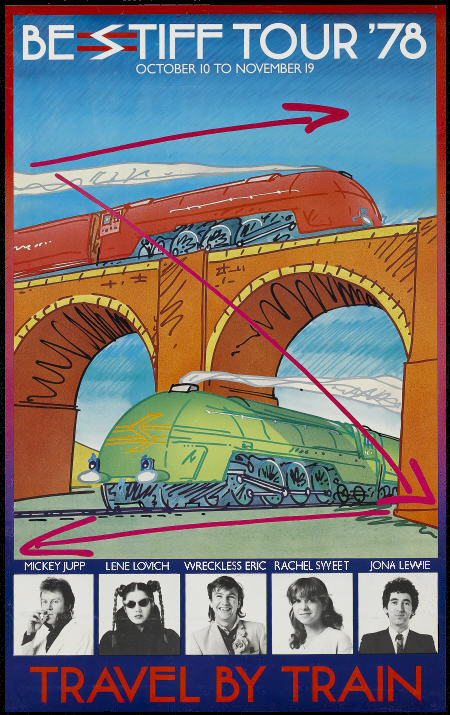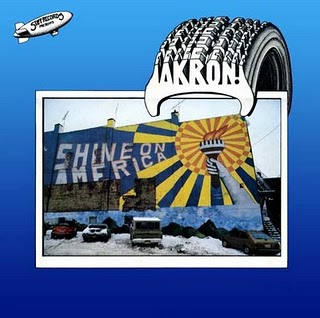BLOG • GRAPHIC NOVELS • WEBCOMIX • NEW CITY STRIP • CITY ARCHIVE • STORE • INTERVIEWS • ABOUT DERF
'Hysterically funny!' –Boston Globe "Brilliant!" –Newsarama 'An incredibly likeable book.' CBG Fan Award winner 152 pages, SLG Publishing, $15.95
|
The true story behind The Rubber City punk scene and The Bank
The Bank New Music Club, the setting of my graphic novel, Punk Rock & Trailer Parks, opened in the Recession-battered downtown of Akron, OH in 1977. It is remembered, by those who recount such things, as one of the greatest clubs of the punk era. Here's a quick primer on The Bank and Rubber City Punk. The Bank was just that, an old bank, one that closed years earlier. A ten-story brick tower that rose high above the other modest, squat buildings on the block, it was once a grand place. The interior was built with marble, mahoghany and brass. Thick velvet curtains hung from the walls and stylish Art Deco chandeliers dangled from the high ceiling. It was a perfect setting for a nihilistic punk scene: an opulent financial institution gone to seed, a physical embodiment of the American Dream gone bust. Fittingly, the tower above the club, a hotel, was now a dreary flophouse. As I detail in the book, punks often rubbed elbows with the weathered mutant denizens of the $5-a-night Anthony Wayne Hotel.
South Main St., where The Bank was located, was Akron's once-bustling retail center, a 10-block-long stretch of department stores, shops, offices and lunchtime eateries that stretched from the Viaduct, a crumbling 1920s-era bridge that spanned the Little Cuyahoga River and rained chunks of concrete on the abandoned homes below, south to the very doors of the hulking B. F. Goodrich tire plant, where my grandfather worked for 45 years. "The Goodrich," as Akronites referred to it, was a massive red-brick factory that covered five full blocks and still, even as the Great Recession gutted the Rustbelt, spat thick plumes of yellow, pungent smoke into the air. As Bank patrons filed out of the club at closing time, the Goodrich plant loomed high into the night sky a mere two blocks away. Akron's tire plants were all shoehorned into the city, often surrounded by residential neighborhoods. That's how fast boomtown Akron grew in the early 20th century. Whole sections of town sprouted up before zoning laws could be passed. Downtown Akron was, for 100 years, the commercial center of city life. Like most downtowns, it fell inexorably into ruin during the Sixties as white-flight, urban sprawl and gleaming, new shopping malls drained it of its vitality. By the late 70s, half the stores were closed, replaced by seedy bars and porno shops. Plywood covered the windows of soot-blackened buildings. Streetlights, the ones that worked, cast the street in an eerie apocalyptic glow. The Bank was the brainchild of the mysterious impresario, Howard Allison. Little is known of the 50-ish Allison. He opened the Bank as a jazz club, apparently undaunted by the preposterous notion of cool jazz in a clanking, backwater factory town. Some big names played there: Jean Luc Ponty, Keith Jarrett, etc. It was open Thursday night through Sunday night and, not surprisingly, the club was struggling. And then a group of punk rock musicians approached Allison and asked if they could play there.
Akron's previous punk club was The Crypt. It was a failing, blue-collar bar in the basement of a building on the far edge of downtown, out near the Goodyear plant. In 1976, some of the more entrepreneurial musicians were scouring Akron for a place to play, having tired of house parties and basements, and asked the owner if they could use his bar for shows a couple times a week, if they guaranteed him a fixed gate. Turned out the owner wanted to bail and retire to Florida and simply gave the bar to the members of Devo, the Rubber City Rebels and the Bizarros. As long as they paid the rent and the utilities, it was theirs. It was here that the Rubber City's soon-to-be-renowned punk scene emerged and quickly attracted an audience and the attention of the music industry. In 1977, Devo and the Rubber City Rebels both signed record deals and left for LA. The Crypt shut its doors, leaving hundreds of punk rock fans and a dozen newly-formed bands without a venue. The Bank's Allision was wary at first, since punk rock was getting a lot of bad press in those days, but allowed punk bills on slow Thursday and Sunday nights, while keeping Friday and Saturday for jazz. But while jazz events were lucky to draw 50 patrons, the punk shows pulled in 10 times that, packed the house, and, of course, rang up a nice beverage profit. It didn't take long until Allison abandoned jazz and embraced punk rock. And so a legendary club was born. The Genesis of Punk Rock Most people think punk rock was born in New York at CBGBs... or in London with the Sex Pistols. Neither. The Pistols didn't form until 1976, inspired by the Ramones. CBGBs opened in 1973 and early punk acts started playing there later that year. Devo was already playing gigs in Akron by that time, as was Rocket From the Tombs up in nearby Cleveland. The Ramones were inarguably the most influential punk band, but Devo and RFTT rose out of the societal muck at the same time. The Akron punk scene started with Devo. The band first formed 1973 in nearby Kent, Ohio, where the five members were attending Kent State University, just a couple years removed from the deadly Kent State Shootings that left Four Dead in O-hi-o. At first, Devo was more of a performance art troupe, combining music, homemade film, costumes and bizarre characters into a (at first) mostly incomprehensible satire of American post-Sixties life. They played house parties and student union, open-mic gigs before a dozen or so friends and family. But the talent was there, and a unique musical vision. Devo was Akron, and their music, with its clanks and pops and staccato rhythms, sounded as if it wafted right off the factory floor. They steadily built an audience, honed their skills and their reputation grew. In Cleveland, a group of record-store clerks banded together to form Rocket From the Tombs, a sonic monster with whip-smart lyrics and a bad attitude, and in Queens, the working-class borough of New York City, most famous as the fictional home of Archie Bunker, a motley collection of high school weirdoes began playing together as the Ramones. Three bands in three different cities, formed at the exact same time, with no knowledge of each other whatsoever.
Devo was the first Akron band to be signed by a label and, after they left for Hollywood, the Akron scene could well have have dried up vanished. Instead, it flourished, surprisingly more vibrant than ever. Dozens of bands formed, as young fans embraced the DIY punk ethos, picked up instruments and started banging out their own music. Tin Huey, The Nelsons, the F-Models, Chi-Pig, Hammer Damage and Unit 5 and a dozen others played constantly all over town, in whatever venue would allow them. By 1980, the year Punk Rock & Trailer Parks takes place, hundreds of scenesters packed The Bank every weekend. Owner Allison himself seldom materialized. The club was run by a few of the head bartenders, who booked the bands and dished out the notoriously watered-down drinks. The Bank became more than a music club. It was a new wave community center, a place for the close-knit punk population to gather and socialize. The Akron Scene created an international buzz. Music critic Robert Christgau wrote A New Wave Rolls out of Akron for the Village Voice and Melody Maker, the influential English music mag, called Akron "the new Liverpool," a punk spawning ground for a distinctive sound, much as the Beatles' hometown had been a generation earlier. It's a hilariously inappropriate comparison now, looking back, but at the time it signaled the start of a white-hot music scene. By 1978, music talent scouts were flocking to The Bank and signing up every band with promise. In London, music clubs put on Akron Nights and played the distinctive Rubber City Sound for appreciative audiences. The bands: Devo The Akron Scene really begins and ends with Devo. None of the other bands had their vision, or their talent, or garnered the deserved critical acclaim of the Spud Boys. And no other band caused such a violent reaction from mainstream rockers. Far from being embraced as hometown heroes, Devo was reviled locally. Their incendiary cover of the Stones Satisfaction was regarded as outright blasphemy by arena-rock fistpumpers. The local rock radio stations refused to play them. I consider Devo's first album Are We Not Men? one of the greatest of the punk era.
The Dead Boys Formed in 1976 out of the ashes of Rocket From the Tombs, the legendary protopunk band from Cleveland, 50 miles north of the Rubber City. RFTT is perhaps the single most-influential band that no one has ever heard of. They were together less than a year, never produced an album or even a single, and played but a dozen or so shows. Their offstage squabbles (and fistfights!) were legendary and the band soon fractured into two distinct outfits, the equally influential art-punk Pere Ubu.... and the straight-on, balls-to-the-wall-punk Dead Boys. The front man of the Boys was an emaciated kid from Akron with a hypnotic stage presence, Stiv Bators. Half the group was from Cleveland, half from Akron. Known for their raucous live shows, the Dead Boys started at the Crypt and then became a CBGB's favorite. Their best songs, Sonic Reducer and Ain't It Fun were originally Rocket From the Tombs staples, and, much like their predecessor, the Boys didn't last long. By 1979, they were done. Stiv Bator went on to front the goth-punk Lords of the New Church before he was struck and killed by a taxi in Paris in 1990.
Chrissie Hynde Hynde was an Akron girl and also a Kent State student. She was a friend of the early punks and a frequent scenester at shows in both Akron and Cleveland. In 1973, she moved to London and became a familiar figure in the growing punk scene there while working as a clerk at Malcolm MacLaren's famous fetish clothing shop, SEX. She formed the Pretenders in 1978 and went on to multi-platinum, world fame. That first Pretenders album is also in my Top Ten of the era. I've never heard anything like it before or since. My City Was Gone, now best known as the opening theme for the Rush Limbaugh Show, was penned by Hynde as a lament for Akron. I don't fault her the payday, but fatboy Rush has forever ruined that song for me.
The Cramps Lux Interior, the towering frontman in high-heel pumps, was born Erik Purkheiser, and raised in the Akron suburb of Stow. The Cramps, pioneers of punkabilly, formed in LA, then relocated to Akron for a couple years, before finding fame as a CBGBs regular. Their classic 1979 debut album, Songs the Lord Taught Us, is a tribute to Ohio's psychotronic culture, specifically the legendary horror-movie host Ghoulardi. Lux died in 2009. Here's my, not surprisingly, favorite Cramps song:
The Waitresses were a side project, formed by Tin Huey guitarist Chris Butler. Naturally, as these things often happen, it went on to far greater commercial success than the experimental Hueys. Their big hit was I Know What Boys Like, an early MTV heavy-rotation staple.
The Stiff Records Artists By 1978, the Akron scene was attracting scouts from every record label, but none showed a keener interest than Stiff Records. The London-based Stiff was on the cutting edge of new music, discovering future stars like Elvis Costello, the Damned and the Pogues. It was Stiff that put out Devo's first single. Rachel Sweet was a 4'10" ingenue from Akron's Firestone High with a big voice. She made a short-lived splash with her teenage jailbait persona. Jane Aire, who fronted the Belvederes, was another Akron girl Stiff backed. Neither were punk or even New Wave, just sort of off-kilter pop. And neither got much notice. It seemed the remarkable Akron talent pool was running dry.
Stiff's fascination with Akron culminated with The Akron Compilation, printed in blue vinyl with a scratch-and-sniff cover that was supposed to smell like Akron's rubber-saturated air (but in reality smelled more like a wet sock). The Akron Comp, released in 1980, featured a dozen local acts, and represented, for many of these, their only nationally-distributed output. The Akron Comp tanked everywhere but in Akron and Stiff moved on, its interest in the Rubber City spent. 1980 was the year the Akron Scene peaked and began, like all music scenes before and since, to steadily fade and ultimately vanish. All the 2nd-generation bands that expected to be signed, as Devo had been, to record deals, never got an offer. Devo, the Pretenders and the Waitresses all had hits on radio and MTV, but the labels seemed to have tired of the Rubber City Sound. One by one, the discouraged groups disbanded, tired of late nights and long van trips and $50 gigs. The musicians gave up the rock-n-roll dream and moved on with their lives, becoming bankers, lawyers, librarians and milk deliverymen. The generation of college kids that filled The Bank graduated and left bankrupt Akron in search of jobs, which the battered Rubber City no longer had. The gargantuan Goodrich plant was abandoned by the company in 1981. The other tires plants closed in swift succession, all moving south to escape the unions. The city died. The new generation of kids was more interested in hair metal and 80s synth-pop. The crowds at The Bank began to steadily dwindle. The Demise of the Bank No when can exactly pinpoint when The Bank closed. The consensus was that it was sometime in 1983. I cheated in PR&TP and had it shutter its doors in 1981, simply for the purposes of the narrative. But the way it closed in PR&TP... suddenly and without warning... is accurate. The remaining bands moved their gigs to another punk club, JB's Downunder in Kent, ten miles to the east, and soldiered on, blind to waning interest. What no one realized at the time, was that this was the end of the Akron Scene. Tastes were changing. The MTV era was underway and music was dominated by the slick pop of Michael Jackson and Madonna and Duran Duran. Underground music was still going strong in places like Southern California, Minneapolis and Manchester, England, but in Akron the plug was pulled and the music stopped. The central gathering place was gone. The punk hipsters were growing up. No one really realized, at the time, what had been lost. The Akron Scene lasted for a full ten years, with its peak running from 1976, when the Crypt opened, until 1980. That's a pretty good run for any music scene. When you're part of it, you think it will last forever. It doesn't, of course, and ends all too soon. The Bank was every bit as vibrant as the far-more-famous CBGBs in New York City. The difference was, the audience at The Bank was working-class locals and college kids, while the CBGBs crowd was comprised of artists, writers, filmmakers and photographers. Every CBGB show was documented in word, picture and film. Not so in Akron. Only a couple dozen grainy photos exist of The Bank, most snapped with the cheap, polaroid cameras of the day. No writer documented it, no filmmaker captured the scene. There's virtually no film footage and little recorded music, outside of the big bands. The Akron Scene simply vanished into memory, leaving an almost imperceptible archival trace. That was one of my goals when I created Punk Rock & Trailer Parks, to recreate the place, the time and the vibe, as not only an homage, but as the most detailed visual record of The legendary Bank. I was not really an active part of the Akron Scene. I went to Bank shows, but I was still in high school, too young to be a mover and shaker or even much of a contributor, and I blew out of town in 1978, a mere two weeks after graduation. My punk years were spent at Ohio State, three hours south in Columbus, where the local scene was but a shadow of Akron's. The record stores were better, though. After it's sudden demise, The Bank stayed empty for the next 12 years, just another rotting building in Akron. The ghost shadows of the letters spelling out "The Bank" remained on the facade. If you pressed your eyes against the grimy front window, you could just make out the shapes of overturned tables and chairs littering the main floor. It made me sad every time I walked past, which I often did, as I was then working at the nearby Akron Beacon Journal. Finally, in 1995, the city demolished the entire block, to clear room for the new minor-league ballpark. Many of the old Bank scenesters showed up to watch the demolition crew blow up the old club. The first blast didn't even faze the solid tower! They really built them to last. It took three blasts to finally topple it in a cloud of dust and debris. And that was the end of The Bank.
|
|
|---|---|---|
